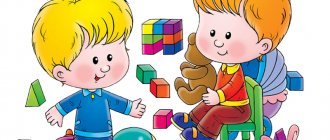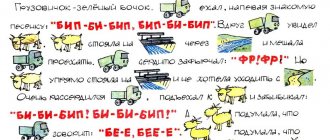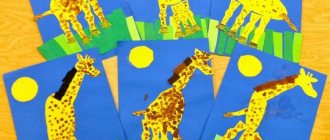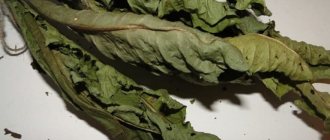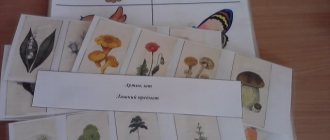At what age should a child be introduced to such a concept as genres of painting in the fine arts? Researchers and scientists from many countries around the world have identified types of fine art and genres of painting for preschool children, and in accordance with this, methods for mastering art have been determined.
About 40-50 years ago in our country, reproductions of paintings by Russian artists hung in almost every house. I remember admiring them as a child and changing places. The most interesting thing is that in the houses of all our friends, all the walls were decorated with similar reproductions. It was such a simple and unobtrusive way that children became acquainted with the wonderful creations of artists. When I became a mother, I also tried to introduce my children to art.
Genres of painting for children 2-3 years old
A child’s acquaintance with art should begin at the age of 2-3 years. At this age, three genres are appropriate: landscape, portrait, still life. You should not explain to your child the meaning of the painting and talk about the artist’s biography. It is necessary to create a cultural space around the child to cultivate good taste.
In the children's room you can organize a small home exhibition (reproductions of paintings by Vasnetsov, Perov, Aivazovsky, Shishkin...), which will be gradually updated and expanded. Parents need to learn to capture children's emotions that the picture evokes. The baby notices beauty, perceives it and receives joy when it comes into contact with it. This is how a child’s first interaction with art occurs.
The French writer Françoise Barbe-Galle gives in her book “How to Talk to Children about Art” an exact comparison of this emotional contact with art: “We can admire a flower without being able to read its Latin name and generally having no idea what it is called.”
For a two-year-old child, a painting is the most interesting object of study. Examine and describe with him what is depicted on it, study the colors, search for objects...
Parents should pay attention to the baby’s reaction and select for viewing those reproductions that will be of interest to him.
In the process of communication, the mother draws the son’s (daughter’s) attention to the reproduction of the painting: “Look out the window. How green the trees are in our yard! They are very tall! And what beautiful trees are depicted in this picture! This is a forest. In the forest you can hear birds singing..." (reproduction of I. I. Shishkin’s painting “Forest”) or
S. Rodionova “Still life with apples”
“Help me put apples in a vase! They are so red, just like in the painting. Look at the picture! Do you like apples? (reproduction of Svetlana Rodionova’s painting “Still Life with Apples”) or “What a handsome boy! His name is Mika. What is he doing? Sits on a chair. His cheeks are pink! Curly hair! The eyes are big! Where is he looking? Maybe he saw a little titmouse outside the window? (reproduction of V. A. Serov’s painting “Mika Morozov”).”
V. A. Serov “Mika Morozov”
When studying the primary colors in painting (red, yellow, blue), you can use reproductions of paintings from different genres where these colors dominate.
This you need to know:
It is very important to observe the measure in the number of reproductions.
For children's perception, it is best to choose large format reproductions (A4, A3) with large contrasting images.
All work should be located at the child’s eye level.
What is a genre of fine art?
The French word "genre" is translated as "genus", "species".
An artist may give preference to one genre or one type of fine art, or he can work successfully in different genres and in different types of fine art (painting and sculpture, painting and graphics...)
Usually the artist is called by the genre that is the main one in his work (battle painter, animal painter, portrait painter, landscape painter...)
All works of fine art are divided into genres that can merge (the Monument to Minin and Pozharsky can be classified as a portrait and a historical genre) and branch out (I.K. Aivazovsky wrote marinas (seascapes) and battles (sea battles). The battle genre can be classified as "branches" of the historical genre).
Mary Richard "Masterpiece! The Greatest Artists of All Time"
The encyclopedia talks about the manifestation and development of different types of art, introduces the main artistic movements, authors and their works.
- The trick is entertaining infographics that make reading easier.
- The uniform format of articles makes it easier to remember information, compare different directions and track their development.
- Develops memory, attention, interest in art, broadens the child’s horizons.
Age limit: 10+. Perfect for both children and adults.
Features of the publication: 96 pages, offset printing.
How to introduce a preschooler to still life?
Still life is a genre of fine art dedicated to the depiction of things surrounding a person: household items, tools, flowers, food (bread, fish, fruits, vegetables...), books, musical instruments, etc.
Home themed exhibitions in the still life genre can be devoted to the following topics: “Bread”, “Flowers”, “Fruits and Vegetables”, “Household Items”.
Such famous artists as I. T. Khrutsky, I. E. Grabar, K. S. Petrov-Vodkin, V. F. Stozharov, K. A Korovin and others worked in the still life genre.
There are two types of still life in fine art.
In one form, things seem to characterize their owner, talking about his position in society, profession, hobbies. It feels like the owner of the things has left and is about to return. For example, the painting “Morning Still Life” by K. S. Petrov-Vodkin.
K. S. Petrov-Vodkin “Morning still life”
In the second type of still life, things are depicted by the artist in order to impress the viewer with their beauty, their color, their shape... For example, the still life of V. F. Stozharov “Bread, salt and brother.”
V. F. Stozharov “Bread, salt and brothers”
When telling your son (daughter) about a still life, you should note:
- Title, author (What is the name of the painting? Who painted it?);
- Content, composition (What do we see?);
- era (when did people use such utensils (such objects)?);
- the artist’s writing style (favorite colors, large strokes...);
- main idea (what is the artist talking about in his painting?)
A story about a still life should be emotional in order to attract the child’s attention:
“What do we eat every day? Bread. And what is it like? How should you treat bread? Look at this picture. It's called "Bread, Salt and Bro." It was painted by the artist V.F. Stozharov. He placed bread in the center of the picture. His bread is tall, round, golden, appetizing... Next to him lie large chunks of a cut loaf. The bread lies on a snow-white embroidered towel. The golden brother and the embroidered towel on the red canvas tell us that bread is the main value on earth.
Bratina – spherical vessel of the 16th-17th centuries. for drinking at brotherly feasts, “for all the brethren.”
The still life is depicted against the background of a log wall illuminated by the sun. The colors chosen by the artist evoke joy and reverence for the bread. The painting by V. F. Stozharov reminds us of a careful attitude towards bread.”
“This still life is called ... . It was written by... It evokes joy and admiration. There is carnation, chamomile, peony... I want to reach out and take such a lush bouquet in my hands to inhale its aroma. What would you call this painting? Who do you think could have collected the bouquet? Maybe it was given to my mother? Did you like the bouquet? What mood does this bouquet make you feel? In what mood do you think the artist painted this picture? What colors did the artist use to convey his mood? Please think about why the artist decided to paint this bouquet?”
While viewing the paintings, you need to pay attention to how bread (flowers, fruits...) was depicted by different artists. In Mashkov’s painting “Moscow Food” the table is full of loaves and loaves, in Petrov-Vodkin’s painting “Herring” there is only one piece of black bread on the table, in Fedotov’s painting “Aristocrat’s Breakfast” the bread can only be noticed if you look very closely at the plot , in Serebryakova’s painting “Lunch” we see bread in the field at the collective farmers’ lunch. What kind of bread looks appetizing (seems warm, I want to try it)?
Album for children of senior preschool age. "We study painting."
Every child is an artist.
The difficulty is to stay
artist, emerging from childhood.
Pablo Picasso
In kindergarten, children are introduced to various types of visual arts available to their age. Using the best images of folk art and masters, teachers cultivate interest and the ability to aesthetically perceive paintings, sculptures, objects of folk art, illustrations in books, form the basis of children’s aesthetic taste, and the ability to independently evaluate works of art. The perception of art develops gradually, so a number of requirements are imposed on works intended for preschoolers. The drawing must be clear, clearly and expressively convey the most characteristic features of the object - shape, color, relative size of parts, position in space. In a plot painting or sculpture, each image must be clearly outlined and characterized, so that children can understand by certain characteristics who is depicted, what he is doing, where and when the action takes place. Composition is essential for understanding a work. Clearly highlighting the main thing (either by the location of the characters or by color) makes it easier to perceive the whole and understand what is depicted.
Some landscapes by Russian and Soviet artists are accessible to children. Works of Russian realistic art of the past are widely represented in kindergartens: I. Shishkin. “Morning in a Pine Forest”, “Ship Grove”, “Rye”; landscapes by I. Levitan “March”, “Golden Autumn”, “Spring. Big Water", "Birch Grove"; seascapes by I. Aivazovsky; paintings by V. Vasnetsov “Alyonushka”, “Ivan Tsarevich on the Gray Wolf”. Still life offers rich opportunities for the development of aesthetic perception. In this genre, the image of objects attracts the child, first of all, with its means of expression - color, shape. Thus, preschool children are introduced to different types of fine arts. These are highly artistic works, rich in ideological content and perfect in artistic form, accessible to a child, both in content and in means of expression. We offer an album for viewing paintings in kindergarten with children of senior preschool age on the topic “Studying painting.”
I. Ostroukhov
I. Ostroukhov “Golden Autumn”
I. Ostroukhov “Golden Autumn”
- What do you think the artist is telling us here? About golden autumn. But the artist spoke about the beauty of a small piece of forest.
- What do we see in the foreground? The ground is strewn with lacy leaves, two old maples with drooping branches and several thin young maples. A little further we see the powerful gnarled trunks of old trees, and even further - the solid bright gold of autumn foliage. But the artist’s observant eye noticed something else interesting in this corner. Yes, two magpies galloping along the path. White-sided magpies tell each other something, some news about the forest and its inhabitants. Her colors are cooler. Yellow and orange tones have a cool, lemony tint, while greens have a bluish tint. We see a light whitish foggy haze. It's early morning. Quiet and calm in the forest. The artist told us how beautiful even a small piece of forest is in autumn, how calmly and trustingly nature reveals its secrets to an observant person. The sun no longer warms as before, but it shines no worse than in summer. This small forest is thoroughly saturated with autumn mood: bright, joyful, lively. Beautiful trees delight the soul and the eye. I really want to visit such a forest. Listen to the rustle of leaves, breathe in fresh, clean, slightly cool air.
I. Levitan
I. Levitan “Golden Autumn”
I. Levitan “Golden Autumn”
One of the few among Russian artists, Levitan knew how to enjoy brush and paint, he knew how to write not only correctly, but also beautifully. All his paintings are themselves phenomena of a purely pictorial nature. That’s why it’s so difficult to talk about them, but it’s so easy to admire them, to surrender to their inexplicable charm...
Autumn in Levitan's paintings is very diverse. It is impossible to list all the autumn days he painted on the canvas. Levitan left about a hundred “autumn” paintings.
They depicted things familiar from childhood: ...lonely golden birches, not yet blown by the wind; a sky like thin ice; shaggy rains over forest clearings. But in all these landscapes, the sadness of farewell days, falling leaves, rotting grass, the quiet hum of bees before the cold and the pre-winter sun, barely noticeably warming the earth, is best conveyed.
- What kind of autumn is depicted here?
- Why do you think the artist called the painting “golden”? What colors did he use?
- How can these colors be called in one word? What are they? Warm, joyful, cheerful.
- What interesting, beautiful thing did the artist see?
- How did you know that he painted birch trees?
- What is more - warm colors or cold ones? That is why nature in the picture seems so joyful, elegant, warm, bright and even solemn. Did you like the picture? Now try, like artists, to draw a golden autumn.
I. Levitan “Spring. Big water"
I. I. Levitan “Spring. Big water"
The greatest masterpieces of Russian spring poetry include the famous painting “Spring. Big water."
The painting depicts the moment of the flood, when “big water” covered the coastal areas, flooding everything around. Tell us about your impressions of the picture. What interesting thing did the artist see?
- Have you seen this? The water spread wide, freely and endlessly, so that it seemed as if it had merged with the blue sky. Glowing with gentle tints, thin birch trees stand in the water. Their whiteness is emphasized by the bright greenery of the spruce and the dark trunk of an old tree. Their shadows are elongated, reflected in the clear mirror of the water. The trees seem to grow both up and down at once.
- Is there a sun in the picture? How did you find out? It is not drawn, but from the shadows of the trees in the water and on the shore, we learn about it. The sun is still dim, but you can feel its warmth.
- What is shown in the foreground, on the left? This is a boat. She stands by the shore warmed and gilded by the sun. Probably, the artist sailed in it to paint his picture from life.
- What feelings do you get when you look at this picture? Yes, there is a feeling of tenderness and charm from the spring awakening of nature, from the anticipation of warmth, the wild blossoming of nature.
- What would you call this painting?
- Why do you think the artist named his painting this way?
- What did he want to draw our attention to? To the riot of the free spring wind, its playful joy. The wind sways the tops of the trees, defiantly ruffles the young leaves, and ripples the waves on the water.
- What time of year is this? This is spring - noisy, green. People call the spring awakening of nature “green noise”.
- What colors did the artist use? The landscape is painted with clean, light colors, giving it transparency and fragility. The picture is filled with spring quiet joy and tranquility, it is full of optimism from the spring resurrection of nature. Bright green, emerald-colored foliage of sunlit trees, grass on the hills, greenish-bluish distance of meadows, high clear blue sky with light running clouds, blue, blue-violet, violet-pink color of water - all these are cold tones. What mood do they create? Yes, a feeling of coolness, freshness, a clear sunny day, the joy of spring.
I. Shishkin
I. Shishkin “Winter”
AND . Shishkin “Winter”
One of the largest and most popular among Russian landscape painters. Shishkin openly and intimately told the viewer about his love for his native land, for the discreet charm of northern nature. He knew Russian nature “scientifically” and loved it with all the strength of his powerful nature. From this knowledge and this love, images were born that have long become unique symbols of Russia. He was called the “forest hero-artist”, “king of the forest”, “old forest man”.
Look at the winter forest and tell us about it, what is it like? Large, dense, impenetrable.
- What kind of trees are these? Huge spruce trees, their branches located high. The artist painted the picture standing close to the trees, so their tops are not visible.
- Are there small Christmas trees?
- What is this lying on the ground under the snow? Yes, these are fallen trees.
- Is there a lot of snow in the forest? What is he like? What colour? There is a wall of trees all around, so the snow is slightly brownish, creamy, and bluish in the deep shade. Only where there is a gap among the trees, a ray of sun illuminated the clearing, coloring the trees in yellowish tones. This makes the snow, in a thick layer, lying in the shade on the ground, on the branches of fir trees, seem even bluer. You and I are standing very close to huge spruce trees, so we can’t see the tops of the trees. Before us are only their huge brownish trunks, which seem warm and alive. Look carefully: is there anyone else alive in the forest? Did you see a bird? She, like the trees, also seemed to fall asleep, dozed off.
- What would you call this forest? “fabulous”, “enchanted”, “asleep”.
The painting is called “Winter”. This is a forest landscape.
I. Grabar
I. Grabar February blue
Teacher's story:
Famous Soviet artist. The artist depicts a February morning, frosty air, an azure sky, a birch grove on a February morning and deep snowdrifts. In the foreground stands a large white birch tree. She is majestic and beautiful. Birch is the pearl of this picture. She is beautiful in her white and brown outfit, with long branches. Last year's yellow leaves remained on the top of the head. The snow around is light blue, and near the birches the snow began to melt. There are dark bluish shadows in the snow from the birch tree trunks. The blue sky above the birches smoothly turns into blue above the strip of forest. In the background of the picture there are small birch trees. Their trunks are also painted with a bluish tint. A single strip of forest is visible on the horizon.
- What did the artist want to draw our attention to here? To the magical beauty of white-trunked birches. The birch tree standing in front of us in the foreground, painted with dense strokes, seems huge and powerful. It is white in color and has many thin white branches. The artist admires the birch tree and admires its beauty. The branches of magnificent birch trees are directed upward, as if in a joyful outburst, they greet the morning. Under the rays of the sun, last year's icy leaves lit up with reddish-red colors; with a light breeze they touch each other, emitting a melodic crystal chime.
- What melody of winter did the artist hear here?
- Tell me how you feel looking at this picture? Yes, it’s February - the end of winter, its last holiday! A holiday of azure, clear and pure skies with bright bottomless blue in the heights. The sun highlighted the pearly whiteness of the birch trees and the lace of the branches directed towards him. The loose snow in its rays became pinkish, with deep blue shadows from the birches. It seems that the air itself rings with purity and transparency. Yes, this is a bright, ringing, joyful, loud, festive and farewell song of the passing winter.
A. Savrasov
A. Savrasov “The rooks have arrived”
A. K. Savrasov “The rooks have arrived”
One day the artist came to the outskirts of the village to look closely at the ancient church. He came for a short while and stayed until the evening. That feeling of spring that he had lived through in recent days, inhaling the heady March air, acquired special strength and charm. The artist opened his sketchbook and began to draw quickly, with inspiration, forgetting about everything in the world. The artist Alexey Kondratievich Savrasov observed such a picture on the outskirts of a Russian village. He rejoiced at spring and the arrival of rooks. And he painted a picture, which he called “The Rooks Have Arrived.”
- What interesting thing did the artist see? He saw how a flock of rooks landed on the birch trees, how they made noise and rejoiced, returning to their old nests.
- Tell us about the rooks. What are they doing? They correct and repair the nests. Below, at the roots of a birch tree, the rook found a twig and holds it in its beak. How many rooks and large rook nests!
- What trees did the rooks choose? Tell us about them. In the center there is an old gnarled birch tree, next to it there is another one, and on the side, on the right, there are several young slender birch trees. It seems that their bare branches have come to life, become warmer, perked up and stretch upward towards the sun. The artist painted birch trees in the center, large; we see them in full height because canvas painting
located
vertically. - Why do you think the rooks chose this place for their nests? It’s calm here: it’s the outskirts of a small village. We see a fence, behind it several low wooden houses and an old white-stone church with a bell tower, and further - fields with darkened snow still lying here and there.
- Tell us about the snow. What is he like? It darkened, became loose, gray, and dirty. In some places the snow has melted: we see a puddle, there are thawed patches at the roots of birch trees and in other places.
- Is there a sun in the picture? How did you guess? Yes, the sun is barely shining through the clouds, it is still dim. We see this in the shadows of the birch trees in the snow. What can you say about the sky? What is it like? The sky is covered with bluish-gray clouds. What would you call this painting? What does it feel like in the picture? The joy of the awakening of nature, the trembling feeling of anticipation of the sun, warmth, spring and a slight sadness over the passing winter.
P. P. Konchalovsky
P. P. Konchalovsky “Lilacs in a basket”
- Lilac in a basket" P. P. Konchalovsky
- —
What interesting thing did the artist see? What kind of lilac did he see? Yes, he was surprised that lilacs come in different colors: white, pink, red, purple, lilac. What can you say about this bouquet? What is he like? Remember, what does lilac smell like?
- “I’ll take our bouquet and give you the opportunity to once again feel this extraordinary, clean, delicate, fresh smell of lilac - the flowers of early summer.” (Bring the bouquet to each child’s face.) Yes, only lilacs smell like that!
- Plucked flowers cannot live long - they will fade, but those drawn by the artist will live forever and bring joy to people at any time of the year. They will give joyful memories. Did you like the picture?
I. E. Repin
I. E. Repin “Apples and Leaves”
“Apples and Leaves” by I. E. Repin
Apples are scattered on a dark brown table, lying on leaves. The apples are elegant, red-green, with shiny barrels. In the center of the picture is a fresh, bright green apple; to his left are two red apples with slightly green sides: one is in front, the other seems to be hidden; a little further away - another, red one, peeks out from behind an apple with a yellow side. To the side, on the right, there is another red apple lying separately. Closer to us, in the foreground, lie several small light brown leaves, and in the center is a twig with pale green leaves. Probably, the artist painted this picture in the late afternoon: a ray of sunlight fell from the top left and illuminated the apples and leaves, highlighting the small leaf especially brightly, and the leaf became light, yellow-brown.
- - Look: if you cover it, then there will be something missing in the picture. Why? All the apples lie on the left, and on the right, if there were no leaves, it would be empty and somehow ugly. The light plays on the leaves and apples. Against a reddish-brown dark background, illuminated apples sparkle like precious stones.
P.P. Konchalovsky “Apples on the table by the stove”
Apples on the table by the stove" P. P. Konchalovsky
- —What do you think the artist wanted to tell us here? Yes, also about the beauty of apples, about how many there are, how different and elegant they are! The artist admires and admires their variety of colors, the beauty of their rounded shapes, their different sizes, their ripeness and juiciness. Let's take a closer look at this still life, compiled and drawn by the artist.
— Which apples did you like best in this picture? Probably the brightest ones are red, red-pink, rosy? They lie on the left on large carved green leaves, like on an openwork napkin. The combination of red and green colors makes apples seem even more elegant. On the right, in a large white bowl with graceful edges, yellow-red juicy apples are stacked, with green leaves barely visible between them. There are so many apples that they do not fit in the bowl; some lie near it. But, besides these apples, the artist painted others - large, greenish-white ones.
There are two piles of such apples: three on the left, in front of the red apples, in the foreground, and three on the right, near the white bowl. These are very tasty apples. If you let them sit for a while, they will turn white, almost transparent. Who can tell me what these little apples are in the foreground on the right? What are they? Have you ever eaten something like this?
— Where are the apples lying? Yes, on a beautiful reddish-brown polished wooden table, which is pushed up to a white tiled stove. The table is massive, on one leg. Do you see how the apples are reflected in its polished surface? Like in the mirror! The whole still life looks elegant against the background of a white stove. The reflections from it sparkle with white spots (reflexes) on apples, leaves and on the table.
P. P. Konchalovsky “Dry paints”
“Dry paints” P. P. Konchalovsky
—
Look at this unusual still life. The artist showed us a corner of the painter's studio. Previously, artists prepared their own paints from dry powders. They diluted these powders with special oil, which is why the paints are called oil paints.
- What do we see in the artist’s studio? A wooden table, and on it there are glass jars and dry paints of different colors in them. What colors did you see, what colors? Here are red, yellow, blue, orange, pink. In rectangular tins there is oil for diluting paints. In bottles and flasks there are varnishes and various solvents; the painter also needs them. In the background, in a white jug, various oil brushes are solemnly lined up in a row, they rise above everything else. In the foreground lies a tube of ready-made green oil paint, next to it is a funnel through the paint. And here is the palette. All objects are lighter than the dark blue-violet background.
The picture seems to remind us that the art of painting begins with such unsightly cans, bottles, and tins. First, the artist must work at the table, prepare his oil paints, and only then he approaches the canvas and begins to paint the picture. Isn't that an interesting still life? It turns out that a still life can be composed of such objects that are not very beautiful in appearance. And he can talk about interesting things unknown to us.
Apples and leaves" I. E. Repin
Apples are scattered on a dark brown table, lying on leaves. The apples are elegant, red-green, with shiny barrels. In the center of the picture is a fresh, bright green apple; to his left are two red apples with slightly green sides: one is in front, the other seems to be hidden; a little further away - another, red one, peeks out from behind an apple with a yellow side. To the side, on the right, there is another red apple lying separately. Closer to us, in the foreground, lie several small light brown leaves, and in the center is a twig with pale green leaves. Probably, the artist painted this picture in the late afternoon: a ray of sunlight fell from the top left and illuminated the apples and leaves, highlighting the small leaf especially brightly, and the leaf became light, yellow-brown.
- - Look: if you cover it, then there will be something missing in the picture. Why? All the apples lie on the left, and on the right, if there were no leaves, it would be empty and somehow ugly. The light plays on the leaves and apples. Against a reddish-brown dark background, illuminated apples sparkle like precious stones.
K. S. Petrov-Vodkin
K. S. Petrov-Vodkin. "Apples on a red background"
“Apples on a red background” K. S. Petrov-Vodkin
- - What is this picture about? What's written on it? Yes, apples.
- - What are they like? Elegant, colorful, ripe, yellow, yellow-green, yellow-raspberry. There is even a white, very ripe apple, which is what they call “white filling.” The apple filled with sweet juice, ripened in the sun, became white, ripe, juicy.
- — What color is there a lot in the picture? Red! Right! This is a red tablecloth.
- - Why do you think the artist put these apples on the red tablecloth? Yes, so that yellow-green, yellow-raspberry apples look better and become even more beautiful. This is such an elegant, bright painting, a still life painting.
V.F. Stozharov
V. F. Stozharov “Still life. Kvass"
Still life. Kvass" V. F. Stozharov
— What did the artist want to tell us about? About peasant life.
In a peasant wooden hut on the table there are: a bottle braided with birch bark, a birch tuesok and a small barrel. Kvass ripens and ferments in them. In the foreground is a wooden bowl filled with kvass and a kvass jug. To the right of the kvassman on the table lie loaves of black bread baked in a Russian oven, between them there is a wooden spoon and a knife. To the left of the bowl are onions with shiny light brown skins. There was nothing tastier for a Russian peasant on a hot afternoon than a sip of cold kvass. And a prison made from black bread soaked in kvass with onions was the most common peasant food.
In the background of the picture we see a white towel, bunches of rowan berries on the wall and painted wooden spoons. How beautiful and warm this corner of simple village life is! How these ordinary, but so familiar things delight the soul of a Russian person.
How to introduce a preschooler to a portrait?
Portrait (from the French word portrait - image) is a genre of fine art dedicated to the depiction of a person or group of people.
Portraits are part of history. They contain images of people from different eras. From the portraits we can understand what kind of world the artist lived in and how he treated people.
The person in the portrait can be drawn in full height, chest-deep (chest-length), waist-deep (waist-length), knee-deep (knee-deep).
According to the rotation of the head, portraits can be: profile, full face (French en face - “from the face”), a quarter turn to the right or left, three quarters, half a turn.
According to the method of execution, a portrait is divided into pencil, pastel, oil, watercolor, engraved, photographic, etc.
According to the nature of the image, two groups are distinguished: ceremonial (an image of a person on a horse, standing at full height or sitting against the backdrop of landscape or architecture) and chamber portraits (a chest-length, half-length image of a person against a neutral background).
A portrait is called a costumed portrait if a person is depicted as a literary (theatrical, allegorical, historical, mythological) character. When naming such a portrait, include the words “in the image” or “in the form.”
A portrait can convey not only the individual features of a person, but also the characteristic features of the era in which the person being portrayed lived.
By the face, posture and gestures of the model, you can guess her behavioral characteristics, temperament and character.
By depicting a specific person, the portrait painter reflects the time, experiences, dreams of his compatriots, as well as his ideals and his attitude towards the model.
The work of famous artists is associated with the portrait genre: V. M. Vasnetsov, A. G. Venetsianov, V. A. Tropinin, K. E. Makovsky, K. P. Platonov, V. I. Surikov, A. A. Plastov, I. E. Repin, V. G. Perov, I. E. Grabar and others.
Children's portraits are close to the feelings of a preschool child. They evoke positive associations in them. Facial expressions and the placement of hands help the preschooler understand the mood, character, and spiritual world of the person being portrayed.
Sample conversation about a portrait:
Questions about the content of the painting: Who is depicted in this painting? What can you tell about him (her)? How old is he/she? What is his/her name? What is he doing? What is depicted next to him (her)? What do these objects tell about him (her)?
Questions that reveal a person’s emotional state and mood: what is the boy (girl) thinking about? What does he (she) see (hear)? What does he/she want to do? What do you see in his (her) eyes? What are they talking about? What does his clothing say? What mystery can be solved by looking at the hands of this boy (this girl)? Why did the artist depict him/her in this pose?
Based on leading questions, the child composes a descriptive story. An approximate story based on the portrait of V.A. Serov "Mika Morozov":
The painting shows a boy. He is 4 years old. His name is Mika. He sits on a big chair. There is a toy next to him. The boy put it aside because he saw a little titmouse outside the window. I see surprise in his eyes. He's about to jump off the high chair and run to the window to get a good look at the beautiful bird.
A story based on the portrait of I. E. Repin “Dragonfly”:
I. E. Repin “Dragonfly”
In this painting the artist depicted a girl. She is 5 years old. She sits on the fence with her legs dangling. The girl looks a lot like a dragonfly. She's not afraid of heights. She has a beautiful green dress. She rejoices in the sun, grass, sky.
During the conversation, you can ask the child to come up with his own name for the portrait, reveal a secret in the picture hidden by the artist, etc.
Genre painting
Historical genre
The historical genre is a work of art that reflects historical events and depicts the heroes of the past. The historical genre often overlaps with the portrait, everyday life and battle genres.
To get acquainted with the historical genre, the works of V. M. Vasnetsov “After the massacre of Igor Svyatoslavovich with the Polovtsians”, K.P. Bryullov “The Last Day of Pompeii”, I. E. Repin “Barge Haulers on the Volga”, etc.
The most prominent representative of this genre in Russian painting is V.I. Surikov (“Menshikov in Berezovo”, “The Conquest of Siberia by Ermak”, “Suvorov’s Crossing of the Alps”, etc.).
V. I. Surikov “Menshikov in Berezovo”
Domestic
The everyday genre is paintings that depict the everyday life of people, their way of life.
The everyday genre can be introduced to a preschooler using the example of the paintings by P. A. Fedotov “Major’s Matchmaking”, “Breakfast of an Aristocrat” and A. G. Venetsianov (“Zakharka”, “On the Arable Land”, “The Barn”).
P. A. Fedotov “Major’s Matchmaking”
Battle
The battle genre - (from the French bataille - battle) - a genre of fine art dedicated to military life.
In the battle genre, the main place is occupied by military campaigns and battle scenes. The battle painter strives to show the most important moment of the battle, to convey the historical meaning of military battles, which brings the battle genre closer to the historical one. Scenes depicting military life connect the battle genre with the everyday genre.
You can introduce a preschooler to the battle genre through the works of the outstanding Russian battle painter V.V. Vereshchagin.
Animalistic
Animalism (from the Latin animal - animal) is a genre of fine art, the main motif of which is animals.
You can introduce your child to the animalistic genre from the books of the famous animalist E.I. Charushin (“About Tomka”, “Wolf and others”), who is both an author and an illustrator. It is important to explain to the child that an animal artist needs to observe the habits of animals for a long time in order to create their image and convey their character.
Drawing by E. I. Charushin
Many animalists endow their animals with human qualities. An example of this is Albrecht Dürer’s most famous watercolor “Young Hare” (1502). The portrait of this hare is similar to a portrait of a man.
Mythological
The mythological genre is a branch of the historical genre that tells about the plots of legends and legends.
The mythological genre can be studied from the drawings of I. Ya. Bilibin in “The Tale of Tsar Saltan”, in “The Tale of the Fisherman and the Fish”, in “The Tale of Ivan Tsarevich and the Gray Wolf”, in the fairy tale “The White Duck”, etc.
I. Ya. Bilibin. Illustration for the fairy tale “The Frog Princess”
The most famous mythological works include the works of M. A. Vrubel “Pan” and “The Swan Princess”.
V. M. Vasnetsov turned to fairy-tale-legendary themes in his work (“Alyonushka”, “Bogatyrs”, “The Frog Princess”, “The Serpent Gorynych”, etc.)
Ways to develop the perception of works of art
The idea of fine art genres is formed not only at exhibitions and excursions to museums, but also during games.
Perceiving works of art is an emotional and intellectual work that requires certain preparation from the child.
Due to the fact that a preschooler is just learning to “read” the three-dimensional space of a picture, he should develop his powers of observation and pay attention to beauty (the combination of colors, the shape of objects) during walks, hikes, excursions, games, etc. It is important to teach the child notice the beauty in living nature so that he can see the beauty in the picture.
A preschooler’s developed perception of works of art is manifested in the fact that he understands what is depicted in the picture and what the artist wanted to tell us.
To develop emotional perception, you can use the technique of “entering the picture”:
How do you feel looking at this picture? What mood does the artist convey to you? Let's imagine that we find ourselves in this forest (in this clearing, on this path, on this mountain...). Touch the tree (water, leaves)! How did you feel? What is it like? Walk through that foliage! Do you hear rustling? Touch the water (grass, leaves, etc.). Look at the sky! What is it like? Try to breathe some air into yourself! How did you feel? etc.
To develop artistic thinking, children should pay attention to expressive means: “With what colors did the artist convey joy to us (silence, peace, excitement, sadness, fear, freshness...)? How would you feel if he took dark colors?”
An attitude technique can express your emotional and personal attitude towards a painting. The preschooler is given the instruction to compose a mini-story based on the picture: “Before you say what you like about this picture and what you think about it, you need to remember what it is called, what it is dedicated to and what the artist wanted to convey to us.
Françoise Barb-Galle: How to talk to children about art
The book is addressed to adults. In order for a child to learn to understand and appreciate works of art, parents need to learn this first of all!
The material is distributed by age: each age has its own characteristics of perception, so the author gives recommendations, but does not set strict boundaries. The basic principle: not every age has its own picture, but any picture is for any age. You just need to present it correctly. The author explains how to “read” a picture, what to pay attention to the child, how to answer his questions. Everything, again, takes into account age.
Modern books on art for children are not just textbooks written in clear and accessible language, they are amazing and unusual publications that can help adults look at familiar things with different eyes. Perhaps going to a museum will no longer seem boring and useless to you...
